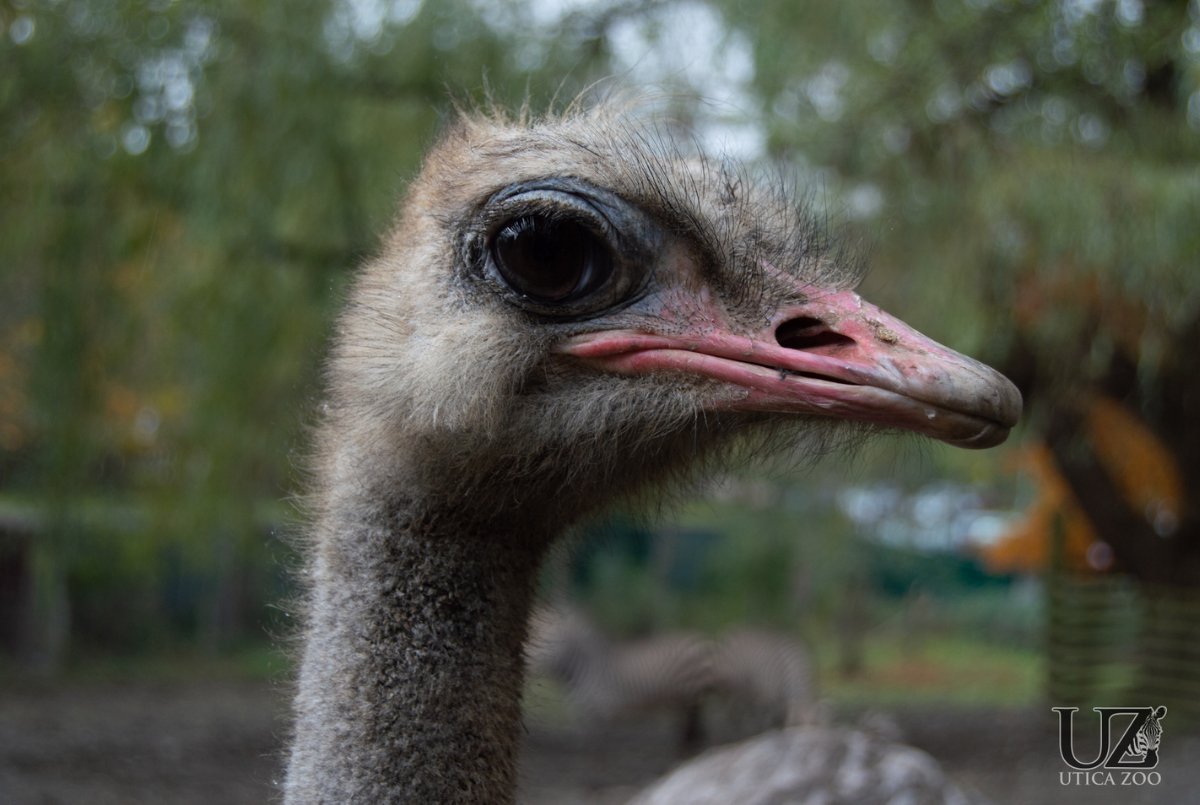Common Ostrich

Basic Information:
Scientific Name: Struthio camelus
Habitat: While the Common Ostrich can be found all across the African continent, the South African subspecies that we have at the Utica Zoo (S. c. australis) is predominantly found in Angola, Botswana, Democratic Republic of the Congo, Namibia, South Africa, Zambia, and Zimbabwe.
Diet: While the common ostrich primarily graze on roots, flowers, and fruits, they have been known to eat insects, lizards, and small tortoises as well.
Size: Up to 9 feet tall / 1.2 to 2 feet long / 6.6 foot wingspan
Weight: 140 to 320 pounds
Lifespan: 10.6 years according to AZA Species Survival Statistics
Distribution Map:
I.U.C.N Conservation Status:

What does this mean?
Least Concern – a species determined by the International Union for Conservation of Nature (I.U.C.N.) to be pervasive, abundant, and thriving.
Our Common Ostriches:
Boomer (Male) – Estimated Date of Birth 1999
Ruby (Female) – Estimated Date of Birth August 2020
Sapphire (Female) – Estimated Date of Birth August 2020
About Commmon Ostriches:
Ostriches are the largest bird in the entire world. They can be found all across the African continent in typical flocks of between 2 and 10 birds, though they can reach flocks upwards of 100. While they are a ratite which means that that are unable to fly, they are capable of running at tremendous speeds. In fact, they can reach up to more than 40 miles per hour when they want to. When they are running at this speed, they can cover a distance of more than 10 feet with each stride. As you can imagine, these powerful legs are also capable of delivering a devastating kick that – in combination with their 4-inch claws – can kill a lion in one blow. However, you can normally find ostriches merely grazing around their habitats. Although Ostrich numbers have drastically declined over the last 200 years, they are still classed as Least Concern by the IUCN. In the 18th century, ostrich feathers were so popular in ladies’ fashion that the ostrich disappeared from all of Northern African countries. If not for ostrich farming, which began in 1838, the ostrich would probably be extinct. Today, ostriches are plentiful and are farmed and hunted for feathers, skin, meat, eggs, and fat.
Did You Know?!
- An Ostrich’s eye is almost 2 inches across, making it the largest eye of any land animal.
- An ostrich is the only bird that has 2 toes. All other birds have either 3 or 4 toes.
- Ostriches hold their wings out when they run to help them balance.
- When a Common Ostrich eats, food is collected in the crop at the top of their throat until there is a large enough lump to slide down their throat. Consequently, Ostriches tend to swallow just about anything from plants and small animals to sand, pebbles, and small stones – the latter three of which help to grind up food in an Ostrich’s gizzard. Because of this, Ostriches are able to digest quite a lot of materials that other animals can’t eat.
- A Common Ostrich’s tough intensities are up to 46 feet in length. This allows an Ostrich to absorb as many nutrients as possible from the materials that pass through it. In fact, Ostriches do not need to drink water because they can absorb all the water that they need from the plants that they eat. However, they will still take a drink from a watering hole if given the opportunity.
- When seeking mates, male Common Ostriches have a fascinating ritual. The black-and-white males use their dramatic coloring to attract the more muted, light-brown females. The male will perform a display where they sink low to the ground right before shaking the feathers on their wings while moving their tail up and down. After this, the male will spread out his wings and stamp toward the female to impress her.
- Male and female ostriches share the responsibility of incubating the eggs. To help with camouflage, the dark feathered males will sit on the nest during the night while the light colored females will sit on the nest during the day.
- While it is typically the dominant female and territorial male of an ostrich flock that mate and create a nest – which is little more than a shallow depression scratched into the dirt by the male – others will mate and proceed to lay their eggs in the “dominant” nest. However, the eggs of the dominant female are always positioned to the center of the nest to ensure the best incubation and protection.
- Ostrich eggs are approximately 6 inches in length, 5 inches across, and weigh about 3 pounds. One ostrich will lay between 7 and 10 eggs in a season, but a communal nest may hold up to 60 eggs from an assortment of ostriches.
- When different groups of ostriches meet, they may challenge each other with short chases. The winning group takes all of losing group’s chicks with them. This can lead to some “nurseries” ending up with 300 ostrich chicks with only a few adults to care for all of them.
- Contrary to popular myth, ostriches do not bury their heads in the sand! When they sense danger and cannot run away, an ostrich flops to the ground and remains still with its head flat on the ground. Since their heads are lightly colored, they blend in with the sand making it appear like it is buried.

